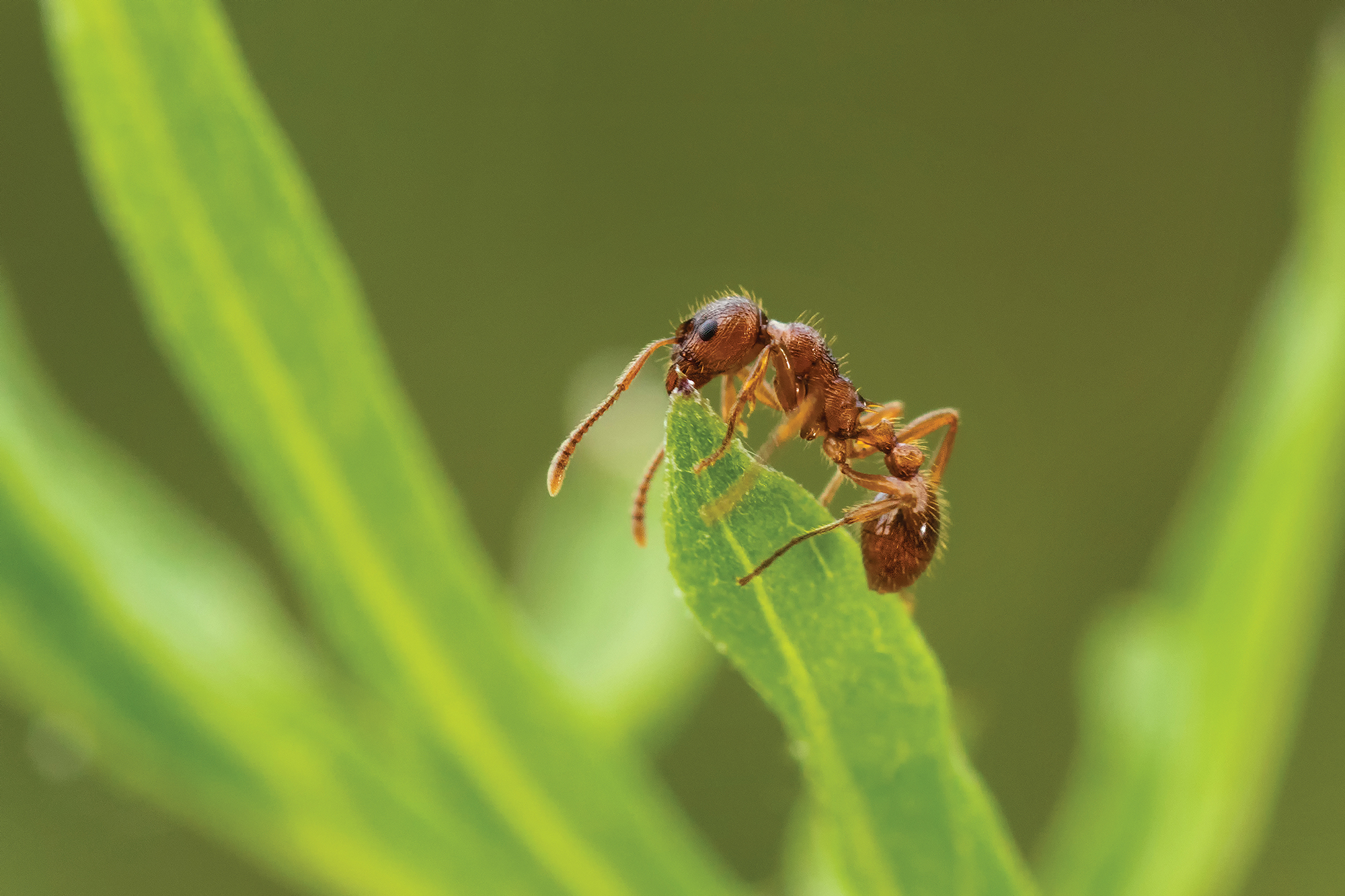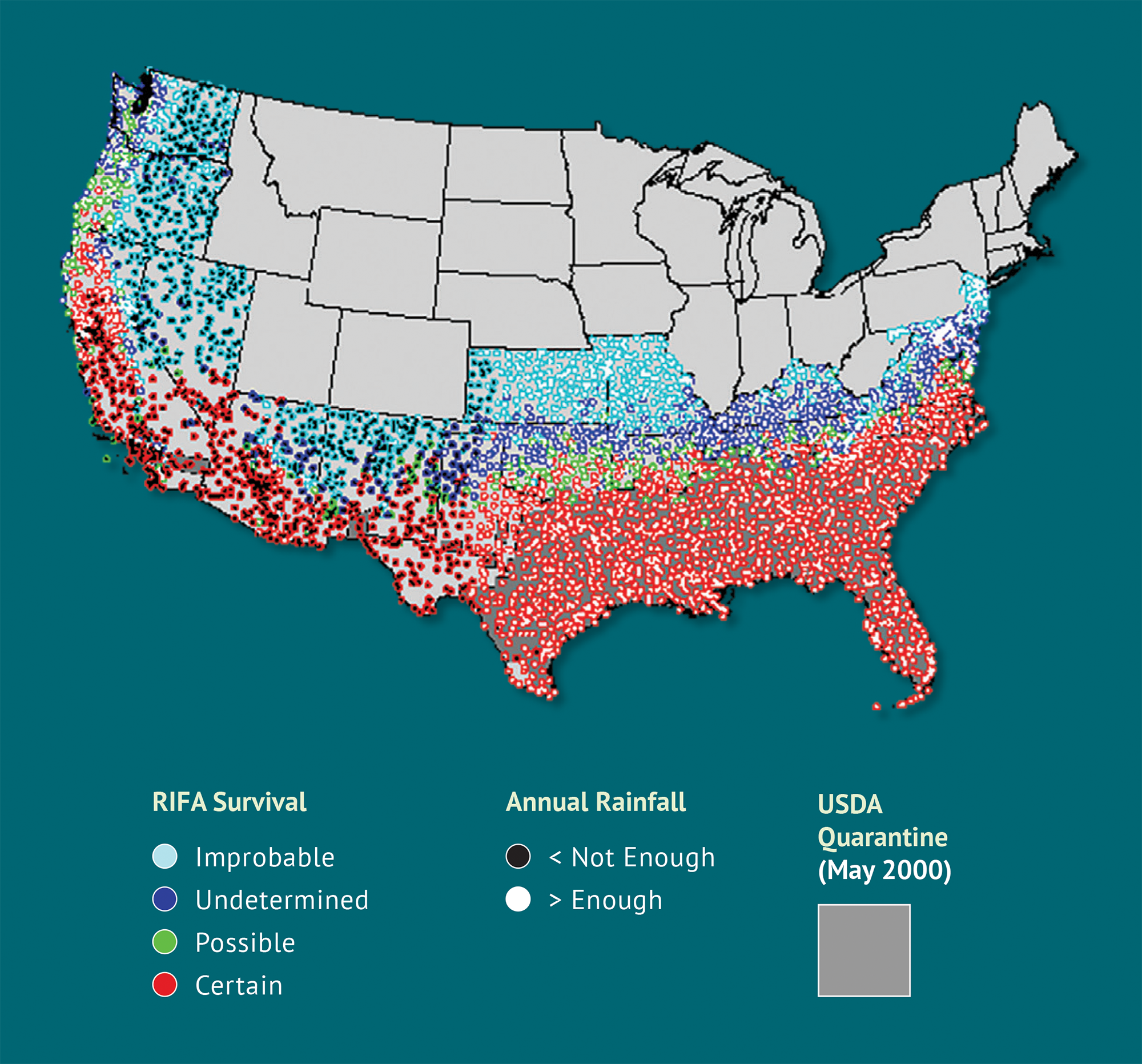
8 minute read
Cover Story
The 411 on Fire Ants
By Terri Billeisen, Ph.D., Turfgrass Entomology Lab, North Carolina State University
Advertisement
INTRODUCTION
In turfgrass, the red imported fire ant (RIFA; Solenopsis invicta) is of primary concern both for its potential to create unsightly mounds and its readiness to sting anyone who disturbs it. RIFA entered the US in the 1930s and quickly spread throughout the southeastern states. Currently, RIFA continues to expand its distribution (Fig. 1) with new counties being added to the USDA quarantine map every year.

Figure 1: Fire Ant Distribution in Southeastern US
USDA image “Potential United States Range Expansion of the Invasive Fire Ant.” Imported Fire Ant and Household Insects, USDA-ARS, 5 Oct. 2017, https://www.ars.usda.gov/southeast-area/gainesville-fl/center-for-medical-agriculturaland-veterinary-entomology/imported-fire-ant-and-household-insects-research/docs/potential-united-statesrange-expansion-of-the-invasive-fire-ant/.
MOVEMENT
Fire ant expansion into new areas can be attributed to both active movement, with newly-mated queens flying to establish new colonies, and passive movement, through the transportation of infested plant material. RIFA queens typically fly 1 – 1.5 miles to establish a new colony and are capable of flying as far as six miles. In the case of severe flooding, fire ants can also link together to create a raft-like structure and float on the water surface into new areas.
MOUNDS
RIFA mounds are more likely to occur in areas of high soil temperature. Turf in full sun or adjacent to an impervious surface such as cement, concrete or asphalt is more likely to attract fire ant activity, particularly in the spring. Fire ants will also take advantage of the extensive root system of trees and large ornamental plants, creating mounds near the base of these plants to use the root network to gain easy access to the water table. Unlike nuisance ants that create mounds with a hollowed-out center with an entrance hole through which they travel, fire ants create dome-shaped mounds and travel in and out via foraging tunnels (Fig. 2). Fire ants will sometimes travel for 1 – 2 feet underground before coming to the soil surface in search of food. For this reason, labeling on many bait products will indicate that baits should be placed approximately two feet from the center of a mound for individual mound treatments. This ensures that foraging ants traveling in and out of the nest will be more likely to encounter the product.

Figure 2: Cross-section of Fire Ant Mound
Greenberg, L., and J.N. Kabashima. Red Imported Fire Ant: Integrated Pest Management In and Around the Home. Edited by K. Beverlin, UC-IPM, Dec. 2013, https:// ipm.ucanr.edu/pdf/pestnotes/pnredimportedfireant.pdf. Adapted from Texas Agric. Exten. Serv. File photo.
SCOUTING
Prior to applying any insecticide for fire ant control, it is essential to confirm fire ants are active and as close to the soil surface as possible. Early in the season, this is usually when air temperatures are in the 50s and after a significant rainfall event. Before application, ensure fire ants are active near the soil surface by placing a potato chip or slice of hot dog 1 – 2 feet from the center of a mound. If fire ants are active, they will find the source of food within 3 – 5 minutes and provide visible confirmation that it is the right time to apply ( Fig. 3 ).

Figure 3: Fire ants foraging on hot dog slice
(Photo Credit: B. Royals, NC State University)
MANAGEMENT
Management approaches for fire ants will depend on a number of factors. Primarily, the number of mounds and required speed of efficacy will determine the best method for application. Application methods can be generally grouped into two approaches: individual mound treatments (IMT) and broadcast applications. Because you are treating each mound individually, this approach is more time-consuming and require large volumes for an effective application. Formulation selection is less important than choosing an appropriate active ingredient, however, for IMT applications, it is best to choose one that has contact activity against fire ants. In an IMT, mounds should be left undisturbed until the equipment and applicator are ready. Products can be applied through soil drench or injection to the top of the mound and should be applied in a large volume to flood down through the tunnels and fill the nest chambers of the mound (Fig. 4). Ideally, enough volume is applied to reach the queen that is likely deep underground. If you are able to reach the queen, this approach can provide long-lasting control and generally uses less product compared to broadcast treatments, which can minimize impact on offtarget beneficial insects in the landscape.

Figure 4: Dry formulation application to Fire Ant Mound
Layton, B. “Control.” Fire Ants, Mississippi State University, http://extension.msstate.edu/content/control.
Broadcast treatments are quick and easy to apply – usually in a spreader or sprayer – to cover large areas. Liquid or granular formulations with contact activity can be effective, however, only ants active at the soil surface will be impacted. Depending on active ingredient, these applications may not have an effect on the colony. An exception to this would be products containing fipronil which will provide much longer lasting control. Unlike IMTs, broadcast applications will impact beneficial insects within the landscape, including native ant species.
Bait products can be applied in either an IMT or broadcast application and can also provide more long-lasting control. Baits must be placed two feet from the center of the mound and kept fresh and dry in order to be effective. If there is significant dew formation on the turf, wait until the areas have dried before placing a bait product. If fire ant control is needed but there is consistent rain in the forecast, give yourself at least a 5-6 hour window for fire ants to forage, find the bait, and bring it back to the nest before it rains. Bait products are considered more “slow-acting” than contact insecticides and provide control within 3 – 14 days of application, depending on active ingredient. See Fig. 5 for a complete list of active ingredients by application method and speed of efficacy.

Figure 5: Diagram for Fire Ant Control. *Note* High vs Low Traffic Area prompt determines the need for immediacy of efficacy. High traffic (or sensitive) areas may require immediate control where baits may not be a realistic option.
Biological control options for fire ants are limited. Botanical or plant-derived products are generally not effective. Products containing spinosad, a soil bacterium, can be effective against fire ants but results are inconsistent. Biocontrol products are generally sensitive to environmental conditions and can be negatively affected by prolonged sun exposure, hot temperatures and dry conditions.
As we start to see temperatures increase, keep an eye out for fire ant activity, particularly following significant rainfall events. In North Carolina, we tend to see a sharp uptick in fire ant activity in late February and early March. Early spring is a great time to get a head start on fire ant control, particularly with insecticides with longer residual or bait products. Unlike other insects in turf, fire ants are very consistent and tend to be an issue in the same areas from year-to-year. The key to effective management is to 1) always make sure fire ants are foraging prior to making an application and 2) select the appropriate application method and product for control. For additional resources, be sure to check out NC Turf Bugs (“Resources” tab) for specific fire ant control and quarantine information. •
Fire Ant FAQs
1. Should I disturb the nest to bring the ants to the surface before drenching?
a. Applicators should drench the mound surface first and then break open the mound with a talc-coated shovel to saturate the interior of the mound.
2. Do fire ants sting or bite…or both?
a. Fire ants sting and cause a skin reaction (blister) where the venom is injected. For most people, it’s an itchy annoyance that lasts a week or two. However, in sensitive individuals, reactions are more severe and can require hospitalization. Fire ants do have mandibles (teeth) that they can use to latch on to the skin while they sting. For that reason, the best way to remove fire ants from your body is to wipe points of contact with your hands to physically separate the mandibles from the skin and remove the fire ants.
3. Do fire ants prefer certain soil types?
a. We observe them more often in clay soils but a lot of that has to do with areas where they are most prevalent. They will infest and inhabit basically any type of soil.
4. Can they be moved from place to place on a mower? Or, are they located in mulch?
a. Yes, it is pretty easy to move individual ants from one place to another on any equipment/vehicles. However, unless you move a newly-mated female to a new area, individual ants are not going to establish new colonies. It’s possible that you can have fire ants in a big (and undisturbed) pile of mulch, but the activities of loading and unloading of that mulch generally disrupt and scatter the colony (if there was an entire colony in one). There are generally a bigger problem in stacks of wheat straw that may be used after seeding a new lawn. If these stacks are undisturbed for months, fire ants might relocate a nest under or in a bale. As such, we recommend keeping the bales off the ground in storage.



